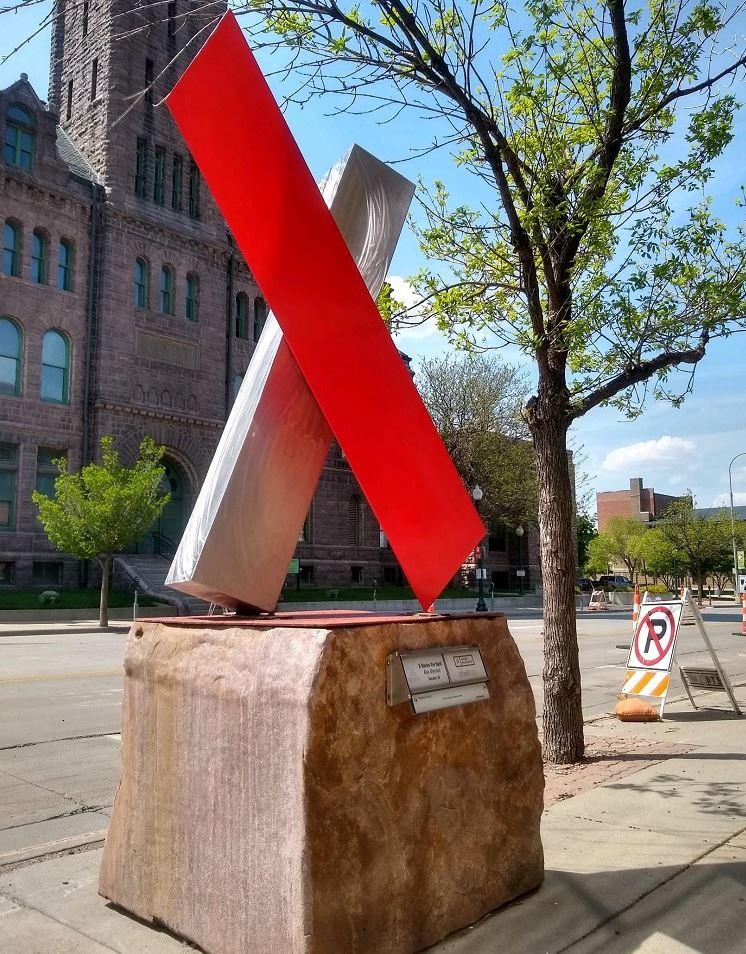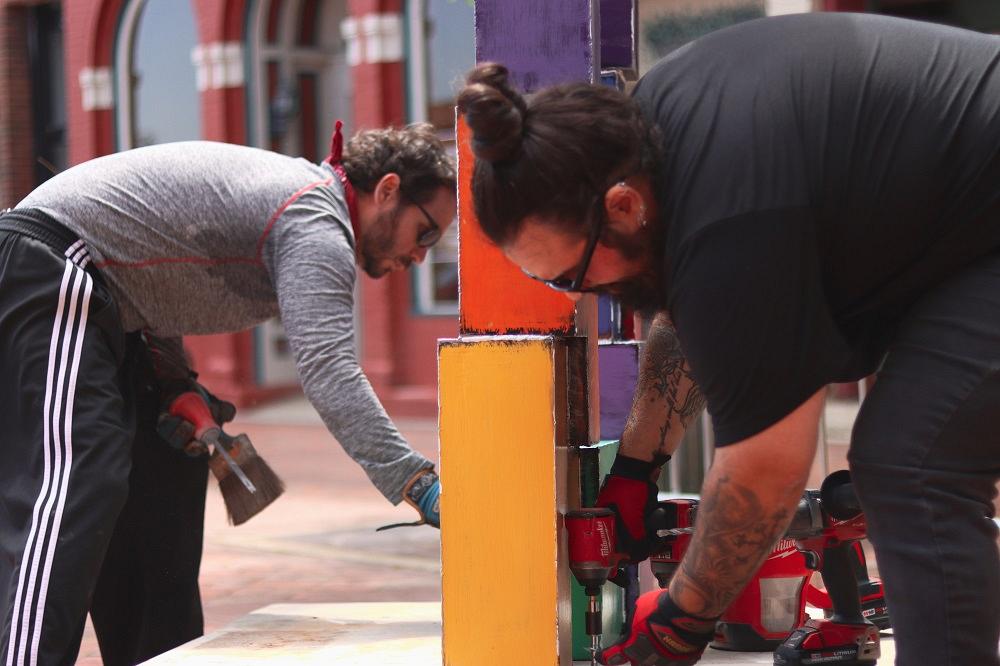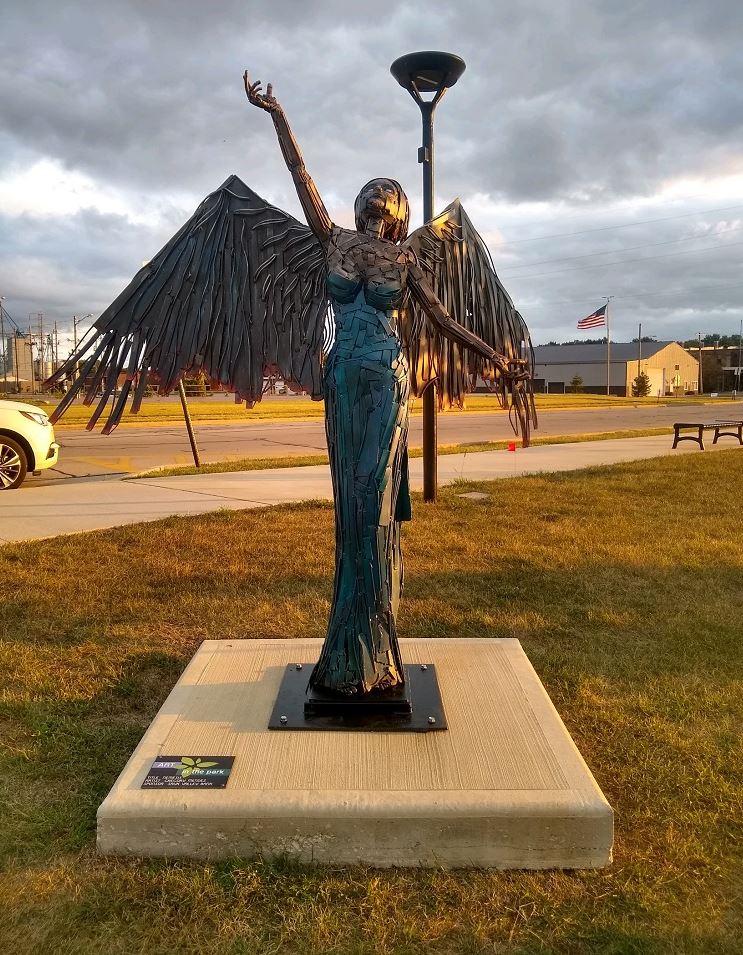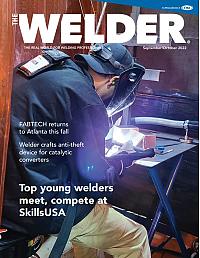Editor
- FMA
- The Fabricator
- FABTECH
- Canadian Metalworking
Categories
- Additive Manufacturing
- Aluminum Welding
- Arc Welding
- Assembly and Joining
- Automation and Robotics
- Bending and Forming
- Consumables
- Cutting and Weld Prep
- Electric Vehicles
- En Español
- Finishing
- Hydroforming
- Laser Cutting
- Laser Welding
- Machining
- Manufacturing Software
- Materials Handling
- Metals/Materials
- Oxyfuel Cutting
- Plasma Cutting
- Power Tools
- Punching and Other Holemaking
- Roll Forming
- Safety
- Sawing
- Shearing
- Shop Management
- Testing and Measuring
- Tube and Pipe Fabrication
- Tube and Pipe Production
- Waterjet Cutting
Industry Directory
Webcasts
Podcasts
FAB 40
Advertise
Subscribe
Account Login
Search
Brothers sculpt with metal, weld to expand art’s public reach
Two metal-sculpting brothers have the same objective: to make art less intimidating to the public
- By Rafael Guerrero
- September 23, 2022
- Article
- Arc Welding
Do metal arts make artwork more visible, more accessible to the general public? Greg Mendez and Alex Mendez think so.
Greg, 40, was the first to venture into metal arts, followed years later by the younger Alex, 31. While the two will occasionally do fabrication work and repairs at their shop in Decatur, Ind., most of their time is spent sculpting.
The two have left their mark on their hometown. Greg was a key figure in establishing the Decatur Sculpture Tour, which started in 2012 and this year features 31 sculptures from 26 artists from across the country—including the Mendez brothers—and places them in visible parts of the eastern Indiana community.
As of this summer, the brothers have just over two dozen large-scale sculptures on public display in states including Indiana, Georgia, Minnesota, Pennsylvania, and South Dakota.
Some of the sculptures will remain on rotation in public art programs. Others could be purchased by hospitals, colleges and universities, or businesses for permanent installation.
“You hope that you don't have to pick them up, because somebody purchased them,” said Alex.
The two spoke with The WELDER to talk about their inspiration, welding, and the approachability of public art through efforts like the Decatur Sculpture Tour.
TW: How did you all get started in visual arts—more specifically, metal sculptures? Where does that stem from?
GM: When we were younger, we always had a stack of comic books on hand to look through. It’s something we both had in common, and to this day you can walk into either one of our houses and still find stacks of comic books.
I ended up attending the University of St Francis - Fort Wayne and its School of Creative Arts. It was during that time that I was able to get an internship with a stone sculptor in Fort Wayne, Cary Shafer. Stone carving is very classical, and he was a very established sculptor. Just being able to see how his studio was attached to the back of his house, being able to spend time with him, and see how he was able to make a living at it was encouraging for someone in art school.

“Hazel” is one of Greg Mendez’s sculptures currently in rotation in public art displays. While this photo was taken in Sioux Falls, S.D., the sculpture is currently in Mason City, Iowa.
But at that age, you’re in your early 20s and everything to do with stone carving is, you know, monetarily out of reach. But what was accessible was a welding machine and scrap pieces of metal.
AM: I started out as a musician at the age of six playing the guitar. From the age of six to 22 or 23, that was my sole focus. I attended college for classical guitar performance.
And that was my main focus pretty much until we took a trip to Sioux Falls [S.D.] to install a sculpture of Greg’s, and I got inspired.
On our drive back, which was 14 hours from South Dakota to Indiana, I worked up the courage to ask, “Can you teach me how to weld? If I'm going to be here with you, if I'm going to do this, maybe I can [sculpt as well].”
TW: Is there any sibling rivalry between you two?
AM: Absolutely. But it's all healthy, and it's always good fun. I think that's one thing that throws a lot of people off—how well we work together despite being brothers.
There is the age gap, and when I was starting out there was definitely a teacher and a student vibe. Once I got a handle on everything and started branching out on my own, I’d come to him like, “Hey, try like this,” “Let me do this.” It's actually gotten to the point now where we'll do something for each other.
We have a rivalry in a way that is conducive and just makes us better.
GM: I think we have different views on this. Our work is so different from one another that when we apply to the same programs, we oftentimes both get in. Alex's sculptures tend to be very, very large—sometimes twice the size of mine. His are large, abstract, brightly colored works and mine tend to be kind of more or less life-size figured pieces. We really don't step on each other's toes.
At this point, Alex has a larger body of work, and his work is dispersed a little bit more throughout the country than mine is. I don't see that as he's doing better than me. It's kind of one of those things where it makes me happy to see him succeed. I want his career to go much further than mine . . . when he succeeds at something, it makes me smile and it feels like I'm succeeding.

Like his brother, Alex Mendez has sculptures installed in multiple parts of the country, such as “X Marks the Spot.”
TW: What attracted you to welding in the first place?
GM: It was a means for me to create large-scale sculptures. It had everything to do with sculpting and creating sculptures. It didn't matter to me what medium, whether it was stone, marble, or steel.
There were a lot of different aspects about creating sculptures out of steel that were appealing to me. And just having the skill of welding seemed like something that would be very, very handy to have as far as being able to repair things and repair some equipment around the shop.
AM: We're both pretty nerdy, and I've always been really into sci-fi and fantasy. And for me, there's just something amazing about the idea of–when you simplify it–using lightning to fuse metal together that it's almost wizardry. You're using this arc of electricity to fuse metal together.
It’s almost therapy, and that's why I've stuck with welding. If I've had a rough day or if I know something's going on, I can look forward to getting to the shop and just weld and disappear behind my mask for a little bit.
TW: And where does your inspiration for your sculptures come from?
AM: So a lot of my very early work was pretty much nothing but guitars, mainly because that was kind of where my mindset still was. Music was still pretty heavy on my mind.
But as I moved forward and slowly got into welding and artwork, I started reaching out to different parts of my life: fantasy and video games, childhood memories, games, things like that.
GM: What has influenced the majority of my work is classical sculpture—ancient Greek and Roman sculptures, mythology. Building off of what Alex said, a very interesting mixture of ancient Greek and Roman mythology along with more modern pop culture. A lot of my work is mostly figurative.
Steel is a very hard, rigid material. I enjoy the idea of creating sculptures that are made of this very rigid, hard material and giving them the impression that they're moving. There's some delicacy to it.
TW: Where did the idea to establish the Decatur Sculpture Tour come from?
GM: When I was in school, part of our curriculum had some art history courses. Going through one of the classes, there was mention of an artist named David Smith, who was born in Decatur. I recognized some of his sculptures, but it really wasn't something that piqued my interest too much.
I started getting pieces into public art programs and meeting other artists. When they found out I was from Decatur, they would immediately make the connection to David Smith because he influenced most of their work. “There must be some awesome sculptures in that town”—and there weren't.
They all knew who David Smith was because he was the first American artist to use welding as a technique to create sculptures; he’s more or less the pioneer of modern sculpture. He was the first to use the different grinding and polishing techniques on stainless steel and pioneered the way for modern art.
The whole reason the Decatur Sculpture Tour started was because I had met other young artists that were directly inspired by David Smith, and they wanted to help bring awareness.
The thing about public art is it’s intended to be accessible to everyone and not be exclusive. I think a lot of people feel intimidated to go into a museum or gallery.
The aspect of creating something out of steel and using welding as a technique, that can be very appealing to someone who is a tradesman, who may not have an interest in art. It could be the technique or the materials that are recognizable in the sculpture that may attract them to it.
TW: And what do people in the trades think of the work coming from you two?
AM: Some of the harshest critiques I've ever had were tradesmen, pipefitters, shop fabricators. They don't really look at the sculpture—they just home in on the welds. Sometimes you mess up and you'll have your heat or your wire speed too high and you've got a bad weld and you say, “Well, I can hide it. The paint will hide it.” Not to a tradesman, as that's the first thing they see.
GM: When you've got pieces that are just loaded with hundreds of pieces of steel, tradesmen are going to come up and notice, run their hands over it, and they're going to know.
They’re going to know that you really put some time into grinding to get this surface smooth and touchable. That's always good to hear when someone familiar with steel comes up and recognizes when you did your due diligence and put your time into making sure this piece was safe.
About the Author

Rafael Guerrero
2135 Point Blvd.
Elgin, IL 60123
(815)-227-8242
Rafael Guerrero. was named editor of The Welder in April 2022. He spent nine years as a journalist in newspapers in the Midwest and Pacific Northwest, covering topics and communities in central Illinois, Washington, and the Chicago area.
About the Publication
subscribe now

The Welder, formerly known as Practical Welding Today, is a showcase of the real people who make the products we use and work with every day. This magazine has served the welding community in North America well for more than 20 years.
start your free subscription- Stay connected from anywhere

Easily access valuable industry resources now with full access to the digital edition of The Fabricator.

Easily access valuable industry resources now with full access to the digital edition of The Welder.

Easily access valuable industry resources now with full access to the digital edition of The Tube and Pipe Journal.
- Podcasting
- Podcast:
- The Fabricator Podcast
- Published:
- 04/16/2024
- Running Time:
- 63:29
In this episode of The Fabricator Podcast, Caleb Chamberlain, co-founder and CEO of OSH Cut, discusses his company’s...
- Trending Articles
Sheffield Forgemasters makes global leap in welding technology

Welding student from Utah to represent the U.S. at WorldSkills 2024

Lincoln Electric announces executive appointments

Lincoln Electric acquires RedViking

Engine-driven welding machines include integrated air compressors

- Industry Events
16th Annual Safety Conference
- April 30 - May 1, 2024
- Elgin,
Pipe and Tube Conference
- May 21 - 22, 2024
- Omaha, NE
World-Class Roll Forming Workshop
- June 5 - 6, 2024
- Louisville, KY
Advanced Laser Application Workshop
- June 25 - 27, 2024
- Novi, MI





























